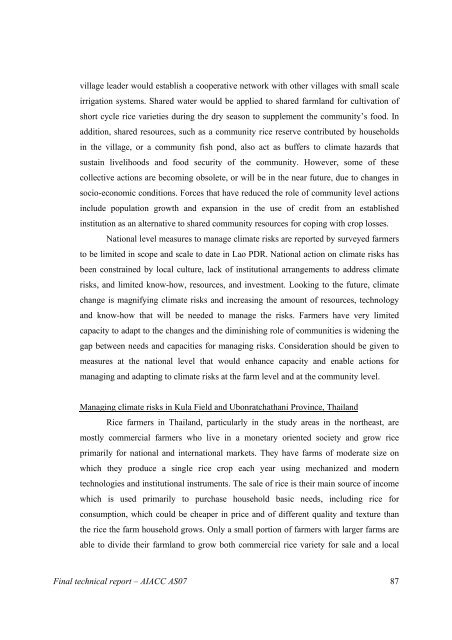Final Technical Report - weADAPT
Final Technical Report - weADAPT
Final Technical Report - weADAPT
- No tags were found...
You also want an ePaper? Increase the reach of your titles
YUMPU automatically turns print PDFs into web optimized ePapers that Google loves.
village leader would establish a cooperative network with other villages with small scale<br />
irrigation systems. Shared water would be applied to shared farmland for cultivation of<br />
short cycle rice varieties during the dry season to supplement the community’s food. In<br />
addition, shared resources, such as a community rice reserve contributed by households<br />
in the village, or a community fish pond, also act as buffers to climate hazards that<br />
sustain livelihoods and food security of the community. However, some of these<br />
collective actions are becoming obsolete, or will be in the near future, due to changes in<br />
socio-economic conditions. Forces that have reduced the role of community level actions<br />
include population growth and expansion in the use of credit from an established<br />
institution as an alternative to shared community resources for coping with crop losses.<br />
National level measures to manage climate risks are reported by surveyed farmers<br />
to be limited in scope and scale to date in Lao PDR. National action on climate risks has<br />
been constrained by local culture, lack of institutional arrangements to address climate<br />
risks, and limited know-how, resources, and investment. Looking to the future, climate<br />
change is magnifying climate risks and increasing the amount of resources, technology<br />
and know-how that will be needed to manage the risks. Farmers have very limited<br />
capacity to adapt to the changes and the diminishing role of communities is widening the<br />
gap between needs and capacities for managing risks. Consideration should be given to<br />
measures at the national level that would enhance capacity and enable actions for<br />
managing and adapting to climate risks at the farm level and at the community level.<br />
Managing climate risks in Kula Field and Ubonratchathani Province, Thailand<br />
Rice farmers in Thailand, particularly in the study areas in the northeast, are<br />
mostly commercial farmers who live in a monetary oriented society and grow rice<br />
primarily for national and international markets. They have farms of moderate size on<br />
which they produce a single rice crop each year using mechanized and modern<br />
technologies and institutional instruments. The sale of rice is their main source of income<br />
which is used primarily to purchase household basic needs, including rice for<br />
consumption, which could be cheaper in price and of different quality and texture than<br />
the rice the farm household grows. Only a small portion of farmers with larger farms are<br />
able to divide their farmland to grow both commercial rice variety for sale and a local<br />
<strong>Final</strong> technical report – AIACC AS07 87
















